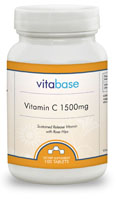| The best sources of vitamin C are fruits and vegetables. About 90% of vitamin C in the average diet comes from fruits and vegetables. Fruit sources of vitamin C include oranges, lemons, limes, grapefruits, tangerines, pears, bananas, melons, papayas, strawberries, mangos, blackberries, blueberries, kiwis, pineapples, watermelons, raspberries, cranberries,
cantaloupes, rose hips, acerola cherries. Vegetable sources of vitamin C include asparagus, broccoli, green peppers, red peppers, cabbage, kale, cauliflower, potatoes, sweet potatoes, yams, squash, peas, turnips, turnip greens, onions, corn, pumpkins, carrots, parsley, sauerkraut.
Citrus fruits such as oranges, orange juice, grapefruit, and tangerines are excellent sources. Melons, kiwi, and strawberries are high in vitamin C. Peppers - sweet green and red peppers and hot red and green chili peppers - are especially rich in vitamin C. Acerola is one of the richest sources of vitamin C in the world. Acerola also contains flavonoids, other vitamins, such as thiamine, riboflavin, niacin, pantothenic acid and beta carotene, and minerals, such as magnesium and potassium. The amount of vitamin C in foods of plant origin depends on the precise variety of the plant, the soil condition, the climate in which it grew, the length of time since it was picked, the storage conditions, and the method of preparation. Cooking in particular is often said to destroy vitamin C - but see the section on Food preparation.
Vitamin C is sensitive to light, air, and heat, so it is best to eat fruits and vegetables raw, or minimally cooked in order to retain their full vitamin C content. Canned vegetables lose vitamin C during processing. Freezing has little effect on vitamin C. Cooking vegetables too long at high heats, for example boiling, can destroy vitamin C. Cutting and slicing fruits and vegetables leaves a greater surface exposed to air and light, which will also destroy vitamin C. Raw fruits and vegetables should be eaten shortly after they were cut. They should be cooked only for a short time in a small amount of water or by steaming. Aging and leaving fruits and vegetables at room temperature too long can also destroy vitamin C. |
